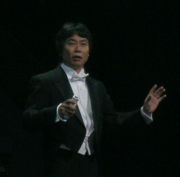Shigeru Miyamoto
Miyamoto demonstrating the Wii Remote during the E³ 2006 press conference.
Born    November 16, 1952
Sonobe (now Nantan), Kyoto
Occupation    Senior marketing director, Nintendo
General manager, Nintendo Entertainment Analysis and Development.
Spouse    Yasuko Miyamoto
Shigeru Miyamoto is the designer that put Nintendo on the map and saved the company from bankruptcy. He is also the composer of the original Donkey Kong video game music – which he composed on a little home keyboard.
Shigeru Miyamoto (宮本 茂, Miyamoto Shigeru?, born November 16, 1952) is a Japanese video game designer. He is the creator of the Mario, Donkey Kong, The Legend of Zelda, Star Fox, Nintendogs, Wave Race, and Pikmin video game series for Nintendo game systems.
He is one of the world’s most celebrated game designers, and is often called the father of modern video gaming. His titles are characterized by refined control-mechanics and imaginative worlds in which the players are encouraged to discover things for themselves, as well as basic storylines, which had been almost unheard of before he introduced one of the first, featuring Mario.
Employed by Nintendo (then a Hanafuda manufacturer) as an artist, in 1980 he was given the task of designing one of their first coin-op arcade games. The resulting title Donkey Kong was a huge success and the game’s lead character, Jump Man — now called Mario — has become Nintendo’s mascot. Miyamoto quickly became Nintendo’s star producer designing many franchises for the company, most of which are still active and very well-regarded. He has also given to many charities as well.
Shigeru Miyamoto has two children with his wife, Yasuko Miyamoto, who was general manager of Nintendo of Japan in 1977. Neither of their children has expressed a desire to go into the family business. He is currently the Director and General Manager of Nintendo Entertainment Analysis and Development (EAD), the corporate sector of Nintendo of Japan. In 1998, Miyamoto became the first person to be inducted into the Academy of Interactive Arts and Sciences’ Hall of Fame.
Early life
Shigeru Miyamoto was born in Sonobe (now Nantan), Kyoto, Japan. As a young boy, Miyamoto loved to draw, paint pictures, and explore the landscape surrounding his house. Stories describe his fascinated discovery of hidden caves, lakes, and other natural features which were linked to his later work. In 1970, he enrolled in the Kanazawa College of Art, and graduated five years later, though he would later remark that his studies often took a backseat to doodling. In 1977 Miyamoto, armed with a degree in industrial design, was able to arrange a meeting with Hiroshi Yamauchi who was a friend of his father and the head of Nintendo of Japan. Yamauchi hired Miyamoto to be a “staff artist†and assigned him to apprentice in the planning department.
Nintendo
In 1980, the fairly new Nintendo of America was looking for a hit to establish itself as a player in the growing arcade market. After successful location tests using prototypes, NoA CEO Minoru Arakawa ordered a very large number of units of Radar Scope, an arcade game. However, by the time the arcade machines could be produced and shipped to the U.S., interest had vaporized, causing Radar Scope to be a huge flop. To stay afloat and clear the costly inventory of Radar Scope, Nintendo of America desperately needed a smash-hit game that the unsold machines could be converted to play. Yamauchi assigned Miyamoto, the only person available, the task of creating the game that would make or break the company.
After Miyamoto had consulted with some of the company’s engineers although he had no prior programming experience, and composed the music himself on a small electronic keyboard, Donkey Kong was fully conceptualized. When the game was complete, the chips containing the new program were rushed to the U.S. and Nintendo employees worked around the clock to convert the “Radar Scope†machines. It was fortuitous that Nintendo had so many units on hand, because Donkey Kong was an overnight success, and not only saved the company, but introduced the character who more than any other would be identified with Nintendo.
The three most famous characters Miyamoto created for the game were Donkey Kong, Jump Man, and Pauline. It was Mario, a character who descends from Jump Man, that has found the most success, and since his debut in Donkey Kong he has appeared in more than 100 games spanning over a dozen gaming platforms.
Miyamoto is usually listed as “producer†in the credits of Mario games. The few exceptions include the Super Mario Land series for the Game Boy, which he had virtually nothing to do with. (Gunpei Yokoi, Miyamoto’s mentor, produced the Super Mario Land series.) In early U.S. releases, he was sometimes credited as “Miyahonâ€, a mistransscription of the kanji in his name (本 — which can be read as either hon or moto). The mistranslated surname was Miyamoto’s development nickname in the 1980’s (having a nickname was a common practice among Japanese game developers at the time).
At E3’s convention in 1997, Miyamoto revealed that he was constantly working with around four hundred people on a dozen or so projects at a time.[1]
Despite being an influential figure in video games and responsible for multi-million dollar franchises, Miyamoto is said to be very humble, insisting on settling for an average income, and often rides a bicycle to work.





